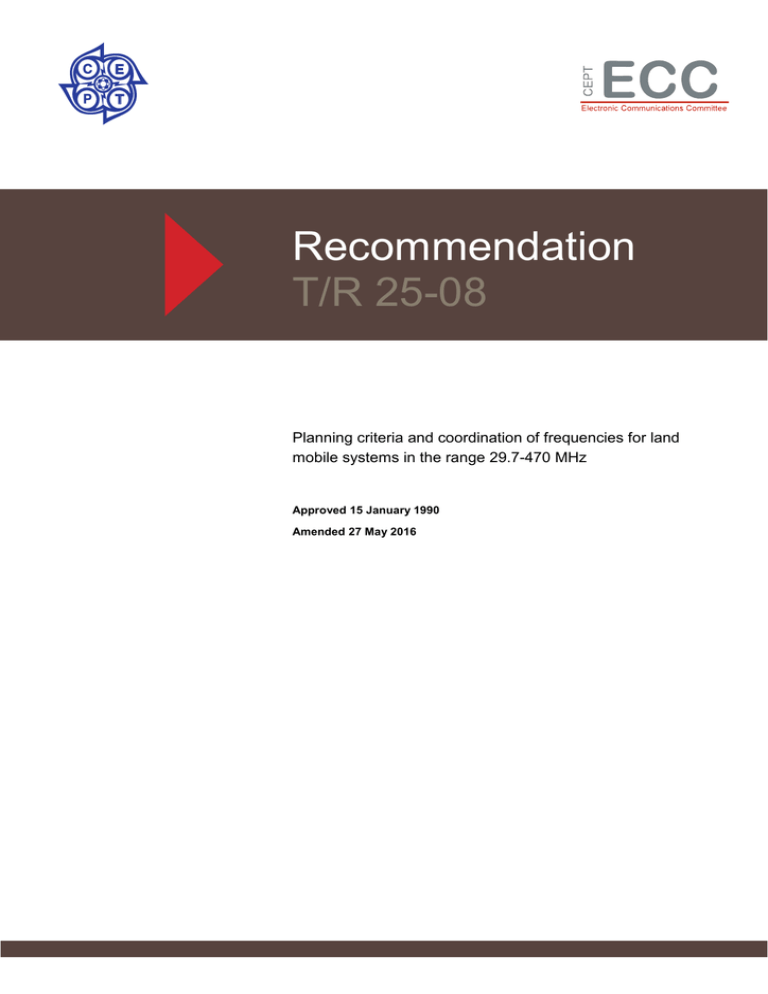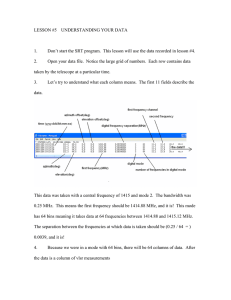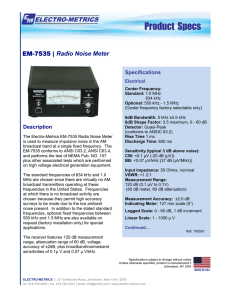T/R 25-08
advertisement

Recommendation T/R 25-08 Planning criteria and coordination of frequencies for land mobile systems in the range 29.7-470 MHz Approved 15 January 1990 Amended 27 May 2016 Edition xx xx xxxx T/R 25-08 Page 2 INTRODUCTION The Recommendation T/R 25 08 was approved in Lecce 1989, and subsequently revised in Vienna 1999, in Utrecht 2005, in Brussels 2008, and in Helsinki 2016 by the Working Group Frequency Management of the ECC. This Recommendation contains provisions for the planning and coordination of frequencies for land mobile systems in the range 27.9-470 MHz for various analogue and digital land mobile applications, e.g. PMR (Professional (Private) Mobile Radio), PAMR (Public Access Mobile Radio), PPDR (Public Protection Disaster Relief), etc., and systems with various channel spacings, e.g. 25 kHz, 1.25 MHz, 5 MHz, etc. The focus is on the interference-free co-existence of systems with different channel spacing on both sides of a border. Such land mobile systems typically can support the industrial sector, transportation sector (including airports and railways) and governmental sector (blue light forces, but also e.g. embassies), life-saving services, the energy/utilities sector (smart metering/smart grids), hotels/tourism sector, financial sector, the agricultural and forestry sector, the retail sector, or electronic communications for the public, e.g. Mobile/Fixed Communications Networks (MFCN). The threshold levels which trigger the coordination between neighbouring countries are based on the principle that indicative coordination thresholds are established at the border-line with regard to a reference bandwidth of 25 kHz. The coordination trigger thresholds were amended during the latest revision of this Recommendation (see Annex 1, section A1.2.3). The new coordination trigger thresholds are relevant for future bi- or multilateral coordination agreements and should also be taken into account for future revisions of agreements. In cases where bi- or multilateral coordination agreements already exist, for example in which levels are agreed in line with a previous version of Recommendation T/R 25-08 or other agreed values, these agreements are still relevant. Edition 27 May 2016 T/R 25-08 Page 3 RECOMMENDATION T/R 25-08 ON PLANNING CRITERIA AND COORDINATION OF FREQUENCIES FOR LAND MOBILE SYSTEMS IN THE RANGE 29.7-470 MHZ “The European Conference of Postal and Telecommunications Administrations, considering a) that coordination between neighbouring countries should be triggered by common threshold levels; b) that each new frequency assignment above the defined coordination threshold level must be coordinated with frequencies already assigned in the same geographical area for use by the stations of neighbouring administration(s); c) that to balance interference-free frequency usage and service coverage needs in border areas, coordination or bilateral agreements are likely to be required; d) that the probability of obtaining a successful coordination diminishes rapidly as a function of the number of radio stations; e) that the difficulties encountered with cross-border coordination depend on a great number of parameters (technical, operational or topographical); f) that agreements have successfully been concluded between some administrations concerning 1) coordination of frequencies for the land mobile service, notably the “HCM Agreement” which also contains details of propagation issues and coordination procedures; g) that in order to facilitate coordination, a large number of parameters (technical and operational) need to be presented in an agreed format; h) that it is desirable that channelling arrangements for the land mobile services be harmonised; i) that in order to reduce the risks of harmful interference and facilitating coordination, the lowest possible antenna height and the lowest possible radiated power, and wherever possible, directional antennas should normally be used; j) that ECC Report 97 contains a study of methods required to carry out the calculations of interference across a border for a number of technologies, but not used for broadband technologies. Administrations may consider using the methods and the results described in ECC Report 97 in their bi- or multilateral agreements; k) that ECC Report 108 contains a study and proposes the method of Border Code Coordination between CDMA-PAMR Systems in the 450 MHz band. Administrations may consider using the methods and the results described in ECC Report 108 in their bi- or multilateral agreements; l) that CEPT administrations may diverge from the technical parameters, propagation models and procedures described in this Recommendation subject to bilateral / multilateral agreements; m) that European common frequency allocations and applications are given in the latest version of ERC Report 25; n) that there are ERC and ECC Decisions, Recommendations and Reports concerning the use of frequencies in the range 29.7-470 MHz; o) that the definitions used in this Recommendation shall be those of Article 1 of the Radio Regulations, unless otherwise specified herein; Edition 27 May 2016 T/R 25-08 Page 4 recommends 1. that CEPT member administrations should enter into coordination agreements with their neighbouring 1 countries. The “HCM Agreement” or parts of it may be used as a basis for these agreements, if applicable provisions are given in the "HCM Agreement"; 2. that CEPT member administrations should endeavour to comply with the provisions in Annex 1 and in Annex 2 when assigning frequencies to stations in the land mobile service, particularly in border areas, where coordination with neighbouring countries is necessary.” 1 HCM Agreement (Harmonised Calculation Method) between the administrations of Austria, Belgium, the Czech Republic, Germany, France, Hungary, the Netherlands, Croatia, Italy, Liechtenstein, Lithuania, Luxembourg, Poland, Romania, the Slovak Republic, Slovenia and Switzerland on the Coordination of frequencies between 29.7 MHz and 43.5 GHz for the Fixed Service and the Land Mobile Service. The latest version of this agreement can be found from http://www.hcm-agreement.eu/http/englisch/verwaltung/index_europakarte.htm Edition 27 May 2016 T/R 25-08 Page 5 ANNEX 1: PROVISIONS RELATED TO OPERATING CONDITIONS AND CHOICE OF FREQUENCIES A1.1 USE OF FREQUENCIES A1.1.1 Harmonised use of frequency bands in different countries Whenever practicable, frequency bands should be assigned for harmonised frequency use by land mobile systems according to Annex 2. For this purpose, relevant ERC/ ECC Decisions and Recommendations, which designate and identify certain frequency bands or their parts for some particular application, should be used as a primary guidance for trans-national harmonisation of frequency use. A1.1.2 Use of frequencies in border area In border areas, a set of frequencies may be shared between certain user groups in adjacent countries in order to make the most effective use of the frequency spectrum. Such shared frequencies shall be frequencies assigned in a particular region, by a bi- or multilateral agreement of administrations concerned, to users with similar traffic conditions and using comparable equipment. The number of stations per channel might also be coordinated in the same agreement. Administrations may also conclude bilateral or multilateral agreement in order to improve the service coverage in border areas (e.g. preferential use of frequencies, code coordination etc.) A1.2 PROVISIONS OF A TECHNICAL NATURE A1.2.1 Channelling A1.2.1.1 Analogue and digital narrowband land mobile systems using a channel spacing up to 25 kHz Administrations should select channel centre frequencies (hereinafter called centre frequencies) using the following preferred formula. This preferred formula should be used whenever possible, but at least in new and re-farmed bands. FCH = Band Edge – (Channel Spacing/2) + n*Channel Spacing where: F CH = channel centre frequency n = 1, 2, 3,… - channel number; Band Edge is lower edge of allocated frequency band, MHz, e.g. 29.7, 54, 68, 146, 174, 380, 406.1, and 440 (see Annex 2) Note: Before 1999 the following old formula was used: F CH = Band Edge + n*channel spacing Channelling arrangements based on this old formula are still in use in some bands in some countries but the usage should be aligned with the preferred formula whenever possible. Edition 27 May 2016 T/R 25-08 Page 6 A1.2.1.2 Digital land mobile systems using a channel spacing greater than 25 kHz Administrations should select centre frequencies as follows: - For systems using a channel spacing of 50 kHz, 100 kHz or 150 kHz the centre frequencies should be selected according to the preferred formula in section A1.2.1.1. - For systems using a channel spacing of 200 kHz the centre frequencies should be selected according to the preferred formula in section A1.2.1.1 with an option to offset these centre frequencies by 100 kHz. - For systems using a channel spacing of 1.25 MHz the centre frequencies should be selected according to the preferred formula in section A1.2.1.1 with an option to offset these centre frequencies by multiples of 12.5 kHz, in order to provide flexibility to locate the centre frequencies in the optimum position within the band. - For systems using a channel spacing of 1.4 MHz, 3 MHz, or 5 MHz, the centre frequencies should be selected according to the preferred formula in section A1.2.1.1 with an option to offset these centre frequencies by multiples of 100 kHz. A1.2.2 Duplex or two-frequency simplex channel separation, location of sub-bands and guard bands In so far as administrations are in a position to define the duplex separation, its values and the respective positions of the sub-bands as given in Annex 2 should be taken into consideration. A sub-band can be simplex or duplex. The lower and upper part of a duplex sub-band should be in the same allocated band. For instance, MS2 in the 146-174 MHz allocated band cannot be paired with BS2 in the 174-230 MHz allocated band. The frequencies of emissions of base or repeater stations should be placed in the upper band and those of mobile stations in the lower band. The same positions of upper and lower bands should be selected for bordering/adjacent countries (see examples in Annex 2). The channel centre frequency of a digital land mobile system using a channel spacing greater than 25 kHz may be selected in a way that the channel pertaining to the centre frequency with its nominal channel spacing falls entirely into a sub-band given in Annex 2 and does not overlap the guard band necessary around the edges of simplex sub-bands and the edges of the lower parts and upper parts of duplex subbands. Edition 27 May 2016 T/R 25-08 Page 7 A1.2.3 Coordination thresholds for analogue or digital land mobile systems The aim of coordination thresholds is to avoid harmful interference between stations located in neighbouring countries. In order to achieve this, indicative coordination thresholds are established which should not be exceeded without coordination between neighbouring countries. 2 Indicative coordination thresholds for land mobile systems (co-channel, 50% locations, 10% time , 10 m receiving antenna height, within a reference bandwidth of 25 kHz, at the border-line) are: 0 dB(µV/m) for frequencies between 29.7 and 47 MHz; 6 dB (µV/m) for frequencies between 47 and 108 MHz; 12 dB (µV/m) for frequencies between 108 and 380MHz; 18 dB (µV/m) for frequencies between 380 and 400 MHz; 20 dB (µV/m) for frequencies between 400 and 470 MHz. For systems using a channel spacing greater than 25 kHz, the following bandwidth conversion formula can be used provided that the spectral power distribution within this channel spacing is uniform within the channel. BC = 10 x log10 (channel spacing / 25 kHz) dB The value (BC) resulting from the formula should be added to the indicative coordination threshold. For all other spectral power distributions, indicative coordination threshold levels should be applied within every 25 kHz bandwidth within the channel spacing. A1.2.4 Planning characteristics in border areas The location, the power and the antenna heights of all stations in the network should be selected in such a way that their range is confined, as far as possible, to the zone to be covered by the intended service. Excessive antenna heights and transmitter outputs should be avoided, by using several locations of reduced height wherever possible. In border areas directional antennas should be used in order to minimise the interference potential. The effective radiated power and the height of the antenna should be as low as possible in relation to the area to be served 2 In certain situations, the 1% time curves should be used for digital systems, e.g. to better protect analogue systems. Edition 27 May 2016 T/R 25-08 Page 8 ANNEX 2: RECOMMENDED DUPLEX SEPARATION, USE AND LOCATION OF SIMPLEX AND DUPLEX BANDS INCLUDING THE UPPER AND LOWER PARTS OF DUPLEX BANDS (BASED ON THE EUROPEAN COMMON ALLOCATIONS TABLE; ERC REPORT 25) App. 18: RR Appendix 18 for VHF maritime communications ARN: Aeronautical radio navigation (ILS/market beacons) In paired bands, the figure above indicates the duplex separation for the individual bands for the pairing of the respective MS (mobile station transmit band) and BS (base station transmit band), e.g. MS1 with BS1 within one frequency range. Edition 27 May 2016


